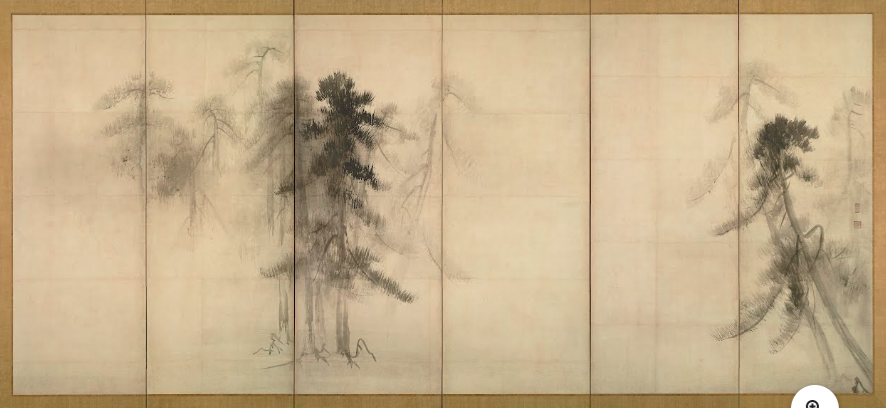
Title: Pine Trees
Creator: Hasegawa Touhaku
Medium: Ink on Paper
Date: Azuchi-Momoyama period, 16th century
Dimensions: w345.1 x 155.1 cm
Repository: Tokyo National Museum, Tokyo, Japan
DVC:
The first thing I noticed was the calming effect that this artwork gave me. The trees depicted on this screen almost appear to be blurred or smeared, as if covered by a layer of fog–that, combined with the beige, natural-colored background of the screen, gives off the idea that this appears to take place within the early morning, in which the morning dew is still evaporating, and the rest of the world is “still asleep.” Moreover, the change in value and opacity(?) of the pine trees creates the illusion of depth, the further, less dark objects appearing to be “further away” because of the higher density in air particles between that object and the viewer. The mountains in the background are also barely visible, and could be mistaken as branches of one of the pine trees, especially given the monochromatic color scheme of the art piece. Considering the background of Shintoism and Buddhism in Japan, perhaps this could be a nod to the inherent connections of the natural world? It’s also important to consider the lack of information on what season it is within the painting–according to “Storytelling in Japanese Art,” written by Masako Watanabe, the presentation of the seasons are an “essential motif within the East Asian iconographic tradition” (Watanabe 22). Pine trees are a type of evergreen trees, so their leaves are not an indicator of whether or not it is fall or winter–their appearance is a constant, unchanging thing. Perhaps, then, the lack of information given to the viewer by Touhaku regarding what season it is is supposed to emulate a sort of timelessness–Watanabe also writes that the “inclusion of all four seasons simultaneously is a sign of eternity and the otherworldly” (Watanabe 22), so perhaps, Touhaku is trying to insinuate this “timelessness.”This screen also appears to not be covered with gold, as opposed to some other screens showed during class. Perhaps this piece is meant to be put in the bedroom, where the flaunting of wealth is not necessary. Or, perhaps this piece has a lack of gold simply because a more “natural” look is prioritized over the more materialistic gold look.
Sources:
https://artsandculture.google.com/asset/pine-trees-hasegawa-touhaku/HgFQR4hgzPorXg?hl=en
https://www.metmuseum.org/art/metpublications/Storytelling_in_Japanese_Art